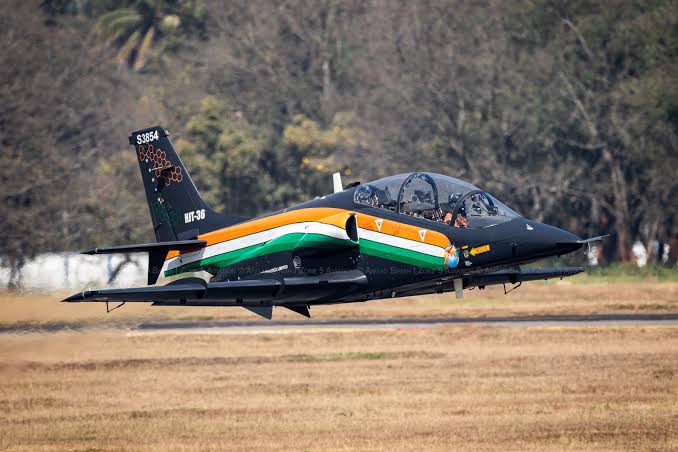HJT-36 Sitara after numerous modification now to enter service as ‘YASHAS’

The HAL HJT-36, initially named Sitara, was to replace the aging HJT 16 Kiran jet trainers. It was to be a conventional subsonic jet trainer featuring low swept wings, a tandem cockpit, and small air intakes on either side of its fuselage.
The design work began in 1997 with government approval coming in July 1999 to develop two prototype aircraft at a cost of ₹180 crore.
The new trainer was to enhance pilot training effectiveness, with a fuel-efficient engine and advanced avionics systems. The first prototype (PT-1) flew on March 7, 2003, followed by the second prototype (PT-2) in March 2004.
Initial operational clearance (IOC) was expected by 2006-07, but then delays came up due to various design challenges, particularly related to stall and spin characteristics.
By March 2010, the IAF placed an order for 73 serial production aircraft despite the IOC not being achieved at that time. The project faced criticism for delays, with costs escalating significantly from initial estimates.
By 2010, the aircraft entered limited series production but was deemed “unfit” for service by Indian Air Force officials due to technological issues related to spin tests.
These issues persisted until January 2022. The aircraft in question faced several significant flaws that impacted its suitability as a trainer aircraft.
One of the most critical shortcomings was its inability to recover from spins, which is most essential for any trainer aircraft. This flaw of spins can occur unexpectedly during flight, and without proper recovery capabilities, pilots could be placed in life-threatening situations.
The initial selected SNECMA Larzac 04-H-20 engine was also deemed inadequate for the aircraft’s operational needs. This led to the adoption of the Russian AL-55I jet engine, which presented its own set of integration challenges.
An aircraft’s propulsion system must align with its overall performance requirements and safety standards.
Another significant design flaw was the limited cockpit visibility, which adversely affected pilot situational awareness. For trainer aircraft, clear visibility is crucial for both instructors and students to monitor flight conditions and respond appropriately.
The original design did not meet these essential requirements, necessitating modifications to enhance visibility and ensure safer training environments.
HAL and IAF both worked together and extensive modifications were carried out aimed at improving its flight characteristics.
This new iteration incorporates significant design modifications aimed at enhancing its capabilities for Stage II pilot training and operational roles including counter-insurgency and aerobatics.
The aircraft underwent significant upgrades, particularly in its engine and cockpit design, enhancing its capabilities as a trainer aircraft for the Indian Air Force (IAF).
The HJT-36 is now equipped with the NPO Saturn AL-55I jet engine, which features Full Authority Digital Engine Control (FADEC).
This advanced system optimizes thrust management, improves fuel efficiency, and enhances safety during high-risk manoeuvres, making it suitable for modern training requirements.
The AL-55I engine delivers a thrust of 17.3 kN, providing a high thrust-to-weight ratio essential for effective performance.
The aircraft’s cockpit has been redesigned with a stepped-up rear cockpit and a drooped nose design, significantly improving pilot visibility and situational awareness—critical factors for effective training.
It now includes a glass cockpit system featuring Multifunction Displays (MFDs), a Head-Up Display (HUD), and advanced navigation and training systems, aligning with contemporary aviation standards.
Analysts note that the Yashas boasts the largest display area among current fighter/trainer aircraft in the IAF.
The upgraded Yashas incorporates an AI-powered voice command system for enhanced training and operational efficiency. The cockpit has eliminated conventional instruments or switches, relying entirely on digital displays.
Aircraft’s aerodynamics were refined to address previous stall and spin recovery issues. Rigorous testing has successfully demonstrated safe recovery procedures, further ensuring the aircraft’s readiness for training missions.
In April 2019, Sitara flew for the first time in three years with a modified airframe to correct its spin characteristics.
The aircraft has undergone extensive modifications to resolve departure characteristics and spin resistance throughout its flight envelope.
It features state-of-the-art avionics and a modern cockpit, enhancing training effectiveness and operational efficiency. The cockpit is fully glass with auto and voice control panels.
The modifications include a reduction in weight and the replacement of imported equipment with Indian-made Line Replaceable Units (LRUs), promoting self-reliance.
It supports aerobatics and armament carriage, with a payload of up to 1,000 kg. The aircraft is powered by a Full Authority Digital Engine Control (FADEC)-controlled AL55I Jet engine, providing an optimal thrust-to-weight ratio and reliability.
Hindustan Jet Trainer-36 (HJT-36), previously known as Sitara, has now been renamed ‘Yashas’ which is fully equipped for Stage II pilot training, including counter-insurgency, counter-surface force operations, and armament training.
A stepped-up rear cockpit with a drooped nose provides improved all-around vision and enhanced situational awareness.
The Indian Air Force (IAF) has approached HAL for a proposal to lease four HJT-36 Yashas Stage-2 trainers for evaluation.
The IAF will evaluate the aircraft’s suitability for future training needs. Further orders may be placed depending on satisfaction with its training and operational capabilities.
HAL has prepared two aircraft, with certification needed for two more.
Rising Like a Phoenix: Dr. D. K. Sunil, HAL Chairman and Managing Director, noted the aircraft has “risen like a phoenix” and is important for the IAF.
Extensive changes have been made to the cockpit and outer design, addressing all previous issues.
The Yashas is expected to meet more rigorous training requirements and has been positioned as a critical asset in modernizing India’s pilot training infrastructure.
The aircraft remains a vital component of HAL’s strategy to provide indigenous solutions for military aviation needs.




